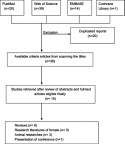Research on central sensitization of endometriosis-associated pain: a systematic review of the literature
- PMID: 31190954
- PMCID: PMC6514255
- DOI: 10.2147/JPR.S197667
Research on central sensitization of endometriosis-associated pain: a systematic review of the literature
Abstract
Endometriosis-associated pain afflicts an enormous number of women who suffer from endometriosis. There is an urgent need to explore the pathogenesis of endometriosis-associated pain to identify targets for treatment of hyperalgesia. A search was conducted in PubMed, Web of Science, Embase, and the Cochrane Library using the search terms "endometriosis" AND ("pain" OR "hyperalgesia" OR "nociception" OR "allodynia") AND "central sensitization". The search was limited to articles published in English from 01/01/2008 to the present. Among the search results, 15 articles were eligible for systematic review, including 6 reviews, 6 human studies (one in the form of a conference abstract only), and 3 animal studies. The articles were classified into 4 lists to describe the mechanism of endometriosis-associated pain and synthesize different aspects of research on it. In conclusion, there is a need to explore the mechanism of endometriosis-associated pain in terms of innervation, vascularization, local inflammation, cross-correlated visceral sensitization, and central sensitization to identify the target molecules and signaling pathways of key genes and relevant biomarkers through new techniques, all with the goal of developing a more comprehensive treatment strategy for endometriosis than is currently available.
Keywords: central sensitization; endometriosis-associated pain; mechanism; neurogenic inflammation.
Conflict of interest statement
The authors report no conflicts of interest in this work.
Figures
Similar articles
-
A Systematic Review of the Efficacy and Availability of Targeted Treatments for Central Sensitization in Women With Endometriosis.Clin J Pain. 2022 Oct 1;38(10):640-648. doi: 10.1097/AJP.0000000000001057. Clin J Pain. 2022. PMID: 35913430
-
Beyond the black stump: rapid reviews of health research issues affecting regional, rural and remote Australia.Med J Aust. 2020 Dec;213 Suppl 11:S3-S32.e1. doi: 10.5694/mja2.50881. Med J Aust. 2020. PMID: 33314144
-
Central Sensitization in Vulvodynia and Endometriosis: What Have We Been Overlooking So Far?Obstet Gynecol Surv. 2023 Dec;78(12):745-758. doi: 10.1097/OGX.0000000000001183. Obstet Gynecol Surv. 2023. PMID: 38134340 Review.
-
Fractalkine/CX3CR1 Contributes to Endometriosis-Induced Neuropathic Pain and Mechanical Hypersensitivity in Rats.Front Cell Neurosci. 2018 Dec 21;12:495. doi: 10.3389/fncel.2018.00495. eCollection 2018. Front Cell Neurosci. 2018. PMID: 30622457 Free PMC article.
-
Pain in Endometriosis.Front Cell Neurosci. 2020 Oct 6;14:590823. doi: 10.3389/fncel.2020.590823. eCollection 2020. Front Cell Neurosci. 2020. PMID: 33132854 Free PMC article. Review.
Cited by
-
Exploration of the core protein network under endometriosis symptomatology using a computational approach.Front Endocrinol (Lausanne). 2022 Sep 2;13:869053. doi: 10.3389/fendo.2022.869053. eCollection 2022. Front Endocrinol (Lausanne). 2022. PMID: 36120440 Free PMC article.
-
Holistic approaches to living well with endometriosis.F1000Res. 2024 Nov 8;13:359. doi: 10.12688/f1000research.142586.2. eCollection 2024. F1000Res. 2024. PMID: 39649833 Free PMC article. Review.
-
Endometriosis-associated chronic pelvic pain.Med. 2023 Mar 10;4(3):143-146. doi: 10.1016/j.medj.2023.02.006. Epub 2023 Feb 28. Med. 2023. PMID: 36858044 Free PMC article.
-
The impact of the microbiota-gut-brain axis on endometriosis-associated symptoms: mechanisms and opportunities for personalised management strategies.Reprod Fertil. 2024 May 1;5(2):e230085. doi: 10.1530/RAF-23-0085. Online ahead of print. Reprod Fertil. 2024. PMID: 38739749 Free PMC article.
-
Endometriosis pain and epithelial neutrophil activating peptide-78 levels.Sci Rep. 2022 Feb 25;12(1):3227. doi: 10.1038/s41598-022-07349-3. Sci Rep. 2022. PMID: 35217683 Free PMC article.
References
-
- Erny R, Guidicelli B. Treatment of pain in endometriosis. Contrib Gynecol Obstet. 1987;16:205–211. - PubMed
-
- Zhang G, Dmitrieva N, Liu Y, McGinty KA, Berkley KJ. Endometriosis as a neurovascular condition: estrous variations in innervation, vascularization, and growth factor content of ectopic endometrial cysts in the rat. Am J Physiol Regul Integr Comp Physiol. 2008;294(1):R162–71. doi: 10.1152/ajpregu.00649.2007 - DOI - PMC - PubMed
Publication types
LinkOut - more resources
Full Text Sources


